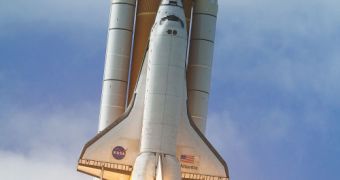Officials at the American space agency announce that the space shuttle Atlantis is currently on track for its final launch, which is scheduled for the beginning of this summer. In preparation for take-off, the orbiter will soon be moved to an integration facility in Florida.
The spacecraft is currently located in the Orbiter Processing Facility-1 (OPF-1), where engineers are verifying all of its instruments, as well as its structural integrity, its heat shields and all systems.
On May 17, the shuttle will be rolled out of the OPF-1 on a special vehicle, and moved the Vehicle Assembly Building (VAB). The latter is the fourth largest building in the world by volume, experts say.
Both structures are located at the NASA Kennedy Space Center (KSC), in Florida, which has been the home of the US Space Shuttle Program (SSP) for more than 30 years now. Atlantis' final flight will mark the end of the SSP.
The roll maneuver is necessary so that the orbiter can be mated with its orange external fuel tank (EFT) and its twin solid rocket boosters (SRB). After integration is complete, and a final series of tests conducted, the entire ensemble will be rolled to the launch pad atop the Crawler Transporter vehicle.
Initially, the orbiter was supposed to launch on June 28, but delays affecting Endeavour's launch schedule prevented NASA from sticking to the original flight manifest. Atlantis' sister spacecraft was supposed to launch on April 19.
Glitches and other malfunctions have forced mission controllers to reschedule the launch for May 16. This pushes back Atlantis's mission – dubbed STS-135 – as well, but officials at NASA say that they don't know by how much just yet.
When it launches, the shuttle will carry out a 12-day mission, but will be manned by a stripped-down crew of just four astronauts. This is the lowest astronaut count on an orbiter mission since Challenger's STS-6 mission, back in 1983.
The main cargo aboard would be the Multi-Purpose Logistics Module (MPLM) Raffaello, which will be accompanied by a Lightweight Multi-Purpose Carrier (LMC). When the orbiter returns, it will carry a failed ammonia pump that gave the ISS crew a lot of trouble back in 2010.

 14 DAY TRIAL //
14 DAY TRIAL //